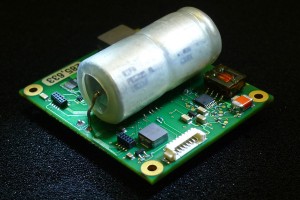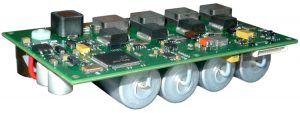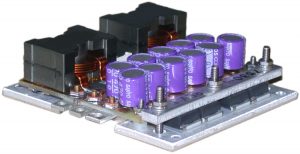Switch Mode Laser Diode Driver
 Approximately 20 years ago, as industry was starting to replace linear designs with switch mode power supplies to achieve smaller size and higher efficiency, Hughes Aircraft Company in 1994 disclosed a resonant buck converter to provide the advantage of switch mode laser diode driver over a linear approach (Patent US 5287372).
Approximately 20 years ago, as industry was starting to replace linear designs with switch mode power supplies to achieve smaller size and higher efficiency, Hughes Aircraft Company in 1994 disclosed a resonant buck converter to provide the advantage of switch mode laser diode driver over a linear approach (Patent US 5287372).
The benefit of switch mode laser diode driver designs is that the power losses associated with the transistor switch do not depend directly on the level of the voltage in the storage capacitor. As a result, the capacitor voltage can be allowed to droop much more than with a linear design and, therefore, fewer capacitors are needed to meet the same operating point resulting in a smaller more efficient unit. In addition, the switching transistors operate in the saturated mode resulting in lower stresses and power loss.
AMI has extended this principle by operating multiple buck converter transistor switches in parallel, but with their timing offset from one another to minimize the amount of ripple seen on the output current pulse. In early 2004, AMI US Patent 7,262,584 disclosed a multiphase, voltage-output power supply that is current controlled and switched to provide current regulated pulses to laser diode loads. In June 2004, the polyphase diode driver patent (US Patent 7,348,948) was filed showing a plurality of switching stages that sum together to produce a current pulse output. This technique has several advantages including:
- Small surface mount parts can be used without the need of a heat sink due to the division of current amongst several stages.
- Typical efficiency is 90%. The power FETs handle only a fraction of the current each, and are operated in a saturated mode for low conduction loss and good reliability. Turn-on occurs at zero current for low switching loss without the complexity of resonant transitions.
- Digital signal processing can be employed to automatically correct for storage capacitor droop and load variations. By this means, the storage capacitor need be only about 25% the size of that used in a linear design.
- Variations in the ESR and capacitance are tolerated as the design can operate from a wide range of storage capacitor voltages without additional stresses to the switches.
- Variations in the voltage of the load due to aging and temperature are also compensated for.
- No output choke or filter is needed. The current waveform to the laser diode is synthesized.
This approach is ideal for diode pumping lasers such as designators where battery life and low peak input currents are important. This design has been qualified for military use and has very stable performance over a long lifetime.
 AMI’s Model 774A exemplifies this technique and delivers up to 200 amps at 44 volts (8kW peak). It includes a power converter stage to charge up the storage capacitor from a variety of inputs and a very high quality sealed storage capacitor.
AMI’s Model 774A exemplifies this technique and delivers up to 200 amps at 44 volts (8kW peak). It includes a power converter stage to charge up the storage capacitor from a variety of inputs and a very high quality sealed storage capacitor.
AMI has developed additional circuits that can provide further benefits when incorporated into diode driver designs. AMI Patent US 6,087,811, submitted 1998, shows how the re-charge rate of a storage capacitor can be adjusted to minimize the peak current drawn from a power source as the repetition rate and thus the required recharge rate is varied. Additionally, AMI Patent US 6,697,402, filed in 2001, demonstrates a way to obtain fast risetimes and high currents using a pre-charged inductor to store and refresh the current to the laser diodes. This technique is especially of value to overcome the series inductance of the load with high currents.
 For diode pumping lower repetition rate laser rangefinders, AMI’s dual-phase switching design was miniaturized, at the request of NVL, to about the size of a stick of gum. This was subsequently modified for digital control, and was repackaged for use in a small, portable rangefinder with burst-mode repetition-rate capability. It should be noted that this design is sufficiently tolerant of capacitor and diode load variations that it is being used with a commercial electrolytic as the storage capacitor. A patent application was submitted in connection with this design for methods of maintaining ripple cancellation with a dual-phase switched current source.
For diode pumping lower repetition rate laser rangefinders, AMI’s dual-phase switching design was miniaturized, at the request of NVL, to about the size of a stick of gum. This was subsequently modified for digital control, and was repackaged for use in a small, portable rangefinder with burst-mode repetition-rate capability. It should be noted that this design is sufficiently tolerant of capacitor and diode load variations that it is being used with a commercial electrolytic as the storage capacitor. A patent application was submitted in connection with this design for methods of maintaining ripple cancellation with a dual-phase switched current source.
The dual-phase diode driver carries out switching transitions with continuous current flow so switching losses are higher than with the Model 774A polyphase design leading to a slightly lower efficiency, but this is still much higher than that achieved when using a linear approach. Timing and duty cycle adjustments are dynamically made as the storage capacitor discharges to maintain the lowest possible ripple and allows most of the energy stored in the capacitor to be used, resulting in a small size. Cost and size are less than the polyphase approach and typical peak output currents are 100 amps. An extension of this design employing multiple phases and a common intelligent controller has been developed to generate pulsed output currents up to 200 amps for designator applications where battery life is critical.
 AMI’s latest switch mode laser diode driver design use our patented polyphase switching into multiple inductors with virtually zero turn on losses and low ripple due to high switching frequency. Efficiencies can be over 90% and a wide range of laser diode load voltages may be accommodated, as well as a range of inputs both below and above the laser diode requirements.
AMI’s latest switch mode laser diode driver design use our patented polyphase switching into multiple inductors with virtually zero turn on losses and low ripple due to high switching frequency. Efficiencies can be over 90% and a wide range of laser diode load voltages may be accommodated, as well as a range of inputs both below and above the laser diode requirements.
© Analog Modules Inc., 2016. This post may be reproduced in its entirety without editing.
This post may be reproduced in its entirety without editing.

 sales@analogmodules.com
sales@analogmodules.com 1-407-339-4355
1-407-339-4355





 Hybrid eyesafe laser rangefinder receiver is designed for laser rangefinding & surveying equipment. Compact construction is ideal for miniature applications. Fast recovery from T0 overload allows ranging to close objects without compromising long range performance. The incorporation of an InGaAs APD gives very high sensitivity with time programmed gain to minimize false targets. Operation at both 1.06 µm and 1.54 µm is possible over a wide range of pulse widths.
Hybrid eyesafe laser rangefinder receiver is designed for laser rangefinding & surveying equipment. Compact construction is ideal for miniature applications. Fast recovery from T0 overload allows ranging to close objects without compromising long range performance. The incorporation of an InGaAs APD gives very high sensitivity with time programmed gain to minimize false targets. Operation at both 1.06 µm and 1.54 µm is possible over a wide range of pulse widths.
